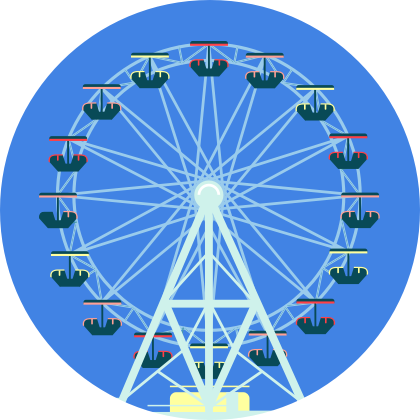
Planning a conference can make even seasoned events professionals feel jaded or overwhelmed – but to win delegate attention today, you’ve got to do more than just tick off your standard checklist.
Successful events leave nothing to chance, and no decision, however small, should be made without careful consideration. Every aspect of your conference is connected and should be aligned to better delight delegates and satisfy stakeholders.

It is a truth universally acknowledged that no organisation hosts a conference without a hidden (or sometimes



When deciding your conference goals, you should also take time to plan how you’ll measure your achievements. Not only will this help you determine if your goals are viable, it’ll also make sure you’re aware of any technology or practices that need to be implemented – for example, a platform to deliver delegate surveys efficiently.
Obviously, all conferences are different. While yours might be a tangle of seemingly contradictory goals, you might alternatively decide the only aim of your event is to make a profit – leaving you with the challenge of finding ways to monetise everything.
Both situations can be daunting but identifying the driving force behind your conference and using it to inform your decision-making will significantly simplify the planning process. You can make sure you’re always choosing a route that helps you achieve your goals by just asking yourself:
How will this conference element help me achieve this goal?
No matter who’s booked to speak or what entertainment is planned, the real superstars of your conference are your delegates. They’re the beating heart of your event and vital to your success.
So, every element of your conference needs to be viewed through the lens of meeting their needs and delivering value (as well as helping you achieve your goals), from the catering and
Of course, delivering this is much easier if you actually know who your delegates are and what they want from a conference. The best way to gain this insight is a tried and tested market research methodology – defining buyer, or in this case delegate, personas.


If you’re not already familiar with persona marketing, it involves creating representations of the core delegates that make up your audience, in order to better understand their needs and motivations. This can be done in four basic steps:

Your finished delegate personas might read somewhat like the following examples, although you should note that these are very simple and the more detail you include, the more insight you’ll discover

Employee Eli is 30-40, married with kids and works for your organisation in a customer-facing role. They’re the household’s secondary earner and their monthly treat is a fancy meal or night out with friends.
Eli takes pride in their job, works hard to hit targets and embraces any training opportunities available, although they’re generally uninterested in wider company performance. Enjoys having something to aim for and appreciates how your organisation rewards hard work.

Customer Charlie is 18-30 and by far the biggest consumer of your product. Extremely loyal to your brand, they recently responded very positively to a promotion offering a more personalised product.
Despite your product already being a substantial expense, Charlie regularly spends additional money on accessories, add-ons and digital content, as well as making purchases from your partners.

Buyer Bailey is 40-50 and in charge of provisioning IT equipment for a company of 100+ employees. Although not currently a customer, they’ve previously purchased from you and attend your conference every year.
Bailey is very interested in industry trends and considers themselves to be on the cutting edge of technology. They are part of a networking group that attends many similar conferences every year and can usually be found closing out a venue’s bar.
Every interaction a delegate has that involves your conference should contribute to moving them closer to taking an action needed for you to achieve your goals – from the first point of contact to the very end of the event lifecycle, and every sight, sound and social interaction in-between.
Your audience should be able to move seamlessly through the delegate journey and so every touchpoint needs to do three things:

When planning you should be able to plot a clear path from the beginning of the delegate journey to the end. If any touchpoints don’t meet the requirements, it’s an opportunity to create new experiences that successfully move delegates along.

While everyone has their own reasons for attending a conference, typically there are predictable trends for both internal and external events. The most obvious difference is that attendees inside your organisation are likely obliged to be there.
Internal delegates are mostly looking to just enjoy themselves as if they were there by choice. These events tend to revolve around an organisation managing change, motivating delegates, educating attendees, or showing appreciation for the audience.
External delegates have made the decision to attend and likely have a specific reason for doing so. External conferences tend to have more explicit commercial intentions, like selling tickets, making a profit or promoting a brand, service or product.
I’m sure we can all relate to the feeling of switching off when we should be paying attention, whether in a meeting, lecture, or at our desk. Delegate engagement is the art of ensuring your audience’s concentration doesn’t slip at the moments your message is most audible.



One way to guarantee delegates get the conference experience they desire is to engage them during the planning process.
Widely available digital tools make it simple to deliver surveys, gather feedback, and empower delegates to vote on experiences they’d appreciate, you can also reward them for participating with digital tokens that can be traded for real-world prizes at your event.
Technology also makes it easier to include attendees in conference activities and enables them to stand up and take centre-stage. Making room for open mic events and soap box discussions takes “giving your delegates a voice” to the next level and guarantees they engaged with your event.


While the day of your conference might understandably be the most important date in your calendar, there are still 364 other days (365 in leap years!) you should also be engaging delegates.
Event communications have a vital role in this engagement and perform many different functions, from simply delivering event details to creating serious hype for the big day. But one of the most underappreciated jobs is reasserting key messaging – before and after your conference.
The lead up to your conference is the perfect chance to create buzz and capitalise on delegate’s inherent FOMO (fear of missing out) with sneak peaks into your event, a slow drip-feed of details and content from previous years.
Your messaging should focus on reasons delegates will benefit from attending, instead of aligning directly with your goals.
In the weeks following your conference you should celebrate the event by sharing plenty of photos and videos, as well as encouraging delegates to do the same – as the experience is fresh in the memory, it’s also the best time to collect feedback. Make sure you check in with your audience, reminding them of why they were there and subtly reasserting key messages.
Any communications professional knows that how you say something is just as important as what you’re saying. Every channel empowers you to talk to delegates differently, so understanding and identifying which are right for your event is vital to your success.
Is a picture perfect or do you actually need 1000 words? Is sliding into delegates’ DMs a
Don’t be afraid to think outside the box in your pursuit of spectacular results. A “public” Facebook Live video can stir up FOMO in even the most anti-social media audience, while a beautifully designed invitation in the post can easily strike a chord with digital natives.

For many, the theme of a conference is simply aesthetic. Nothing but bells and whistles to distinguish one event from another with a slightly different variation of posh frocks, fancy food and dad dancing.
This is the kind of thinking that delivers copy-and-paste conferences delegates have come to dread. Instead, your theme should set the tone for the entire event and needs to:

Your theme informs the look and feel of your entire conference, so it’s likely to be what delegates remember best when they leave. Therefore, it’s vital it communicates the purpose of your event at first glance and it should always be aligned with your branding.
Themes work best when you keep them simple, they’re easy to understand and can be applied to every touchpoint in the event lifecycle.
The last thing you want is attendees switching off before they’ve really heard your message, so your theme needs to grab delegates’ attention before they even step foot in the venue. You should avoid selecting anything that might be unappealing to any of your delegate personas or that excludes anybody – regardless of gender, sexuality, age, race, religion or any disabilities.
Deliver an experience that makes delegates feel they’re part of something a world away from the humdrum of the 9-5 by immersing them in your theme. Incorporate it into every aspect of your event, from comms to catering, as well as every nook and cranny of your venue – for example, provide opportunities for attendees to create and share social media content, like photobooths or event


Choosing a venue that reflects your brand and helps set the tone for your conference is pretty much “Events 101” – but what does the way you lay out your event say about you?
As an
In short, if your delegates switch off, they won’t hear your message. That’s why today’s conferences borrow heavily from the festival experience, with as much emphasis on entertainment as education.
It’s now not uncommon for live music and stand-up to be booked alongside keynote speeches or to see traditional exhibition stands replaced with tech showcases and interactive experiences.
You may already be following in the footsteps of events like SXSW, by integrating

If you want to choose the right speaker for your conference there’s so much more to consider than just their ability to deliver an entertaining keynote.
The second they step onto your stage to address your delegates they become more than just a public speaker – they’re a representation of your entire event. So it’s vital you weigh up whether they reinforce your goals, resonate with the audience and reflect the tone you want to set.


It might be cliché, but this DIY attitude has proved successful for many conferences, and we often see in-house speakers receive thunderous applause, despite lacking the star-power of a guest speaker.
Looking internally is a great way to stretch your budget further, retain more control over the speech’s message, and establish your organisation as the home of thought leaders – you may even unearth hidden talent in your ranks.
This can be an especially effective route to take when your speaker needs to be highly knowledgeable about the intricacies of your industry, understand the nuances of your corporate culture or have a background specific to your organisation.
It’s also a great opportunity to reward employees with time in the spotlight and integrate delegate-led content into your conference. And if your in-house candidate lacks confidence or public speaking experience, it’s easy to find training. In fact, this is a service Penguins offer to our customers.


One sure-fire way to set your event apart from other conferences, is to forego traditional keynotes in favour of more entertaining fare – capitalising on festivalisation.
Of course, no matter how enjoyable your entertainment is, it’s vital you align it with your goals and branding. It makes little sense to treat your delegates to a fully illuminated funfair at a sustainability conference or host an all-you-can-eat buffet at a heart disease summit.
The technology a conference uses is as integral to success as the choice of entertainment or communications strategy. Even relatively modern advances like e-ticketing, digital surveys and event apps aren’t just expected by delegates, they’re vital to ensuring an event runs smoothly. However, in this brave new world of conferencing, even providing important functionality soon won’t be enough, as organisers begin to fully understand the significance of delegate engagement.
For example, once upon a time the majority of delegates were happy carrying around an actual event programme. Yet, as soon as it was possible, they wanted digital versions instead. Now, as well as receiving the information upfront they want to be notified just before a speaker takes to the stage. Giving them enough time to grab a drink and find a spot in the crowd.
As well as turning a blind eye to any tech that can’t provide what they need when they need it, conference attendees have zero use for anything crowbarred into their experience. VR might still be “on trend”, but if it doesn’t add value to the experience, delegates simply won’t engage with it.


To make sure the conference technology you use is the right fit for your audience, ask yourself:

Automatically sends or receives data to devices within range. Great for delivering location-targeted content and collecting feedback on footfall.

Provides comprehensive analysis of how delegates spend time at your conference. Great for identifying bottlenecks in audience flow and engagement hot-spots.

Enables delegates across the globe to enjoy your conference experience thanks to live video streaming, live-chat and VR technology.
Creating an enjoyable conference experience is obviously extremely important, but it’s vital you keep in mind that the event is just means to an end – ultimately, success is only judged on whether you achieve your goals.
Simply comparing event data to your goals will provide a basic understanding of your achievements. However, this stage of the conference lifecycle is an opportunity to gain in-depth insight into how your event (and you, as a conference organiser) performed. Don’t be scared to dive deeper into your data to find answers.
Thankfully, collecting and analysing data no longer requires manually wading through spreadsheets, tally charts, and budgets, so discovering actionable insight into your event now takes far less time and effort.
This can give you more time and energy to reflect meaningfully on the results. Your own observations and data complemented with the strategic use of readily available tools will empower you to answer questions like:
The final stage of the conference lifecycle brings you full circle, as you begin to set resolutions for next year. Remember, it’s never too early to start doing the necessary groundwork for your next event by thinking about:

Planning a conference can often feel like you’re just fumbling around in the dark, trying to make your way through a never-ending list of decisions.
Hopefully you now understand that every one of these decisions is an opportunity to better engage your delegates and provide an amazing conference experience. That’s why every choice needs to be viewed as a vital part of your event strategy.
Ultimately, setting clear, measurable goals and developing a well-rounded understanding of your delegates will provide insight that’s valuable throughout the entire event lifecycle. It may seem simple, but the importance of confidently answering the following questions cannot be overstated:
How does this element of my event help me achieve my goals?
How does this element of my event help me delight my delegates?
For every individual element of a conference, you should consider the wider effect on both delegate engagement and whether you achieve your goals. For example, your theme isn’t just set dressing, it’s an opportunity to assert your message, dictate the event’s tone, and reinforce your brand values.
Hopefully, by reading this guide, you’ve discovered a new way of looking at conferences and are ready to turn your next event into a goal-orientated, delegate-centred event.

Talk to our events experts today for advice and guidance on planning the perfect conference.